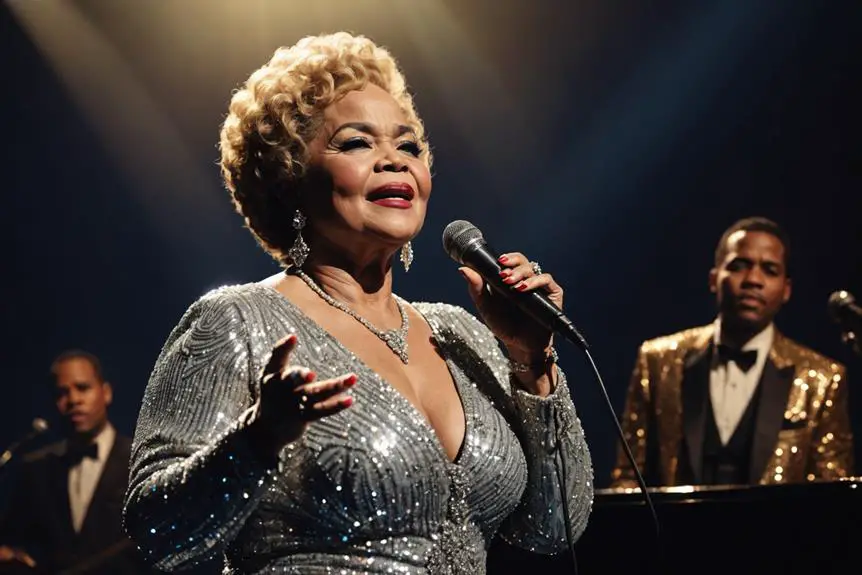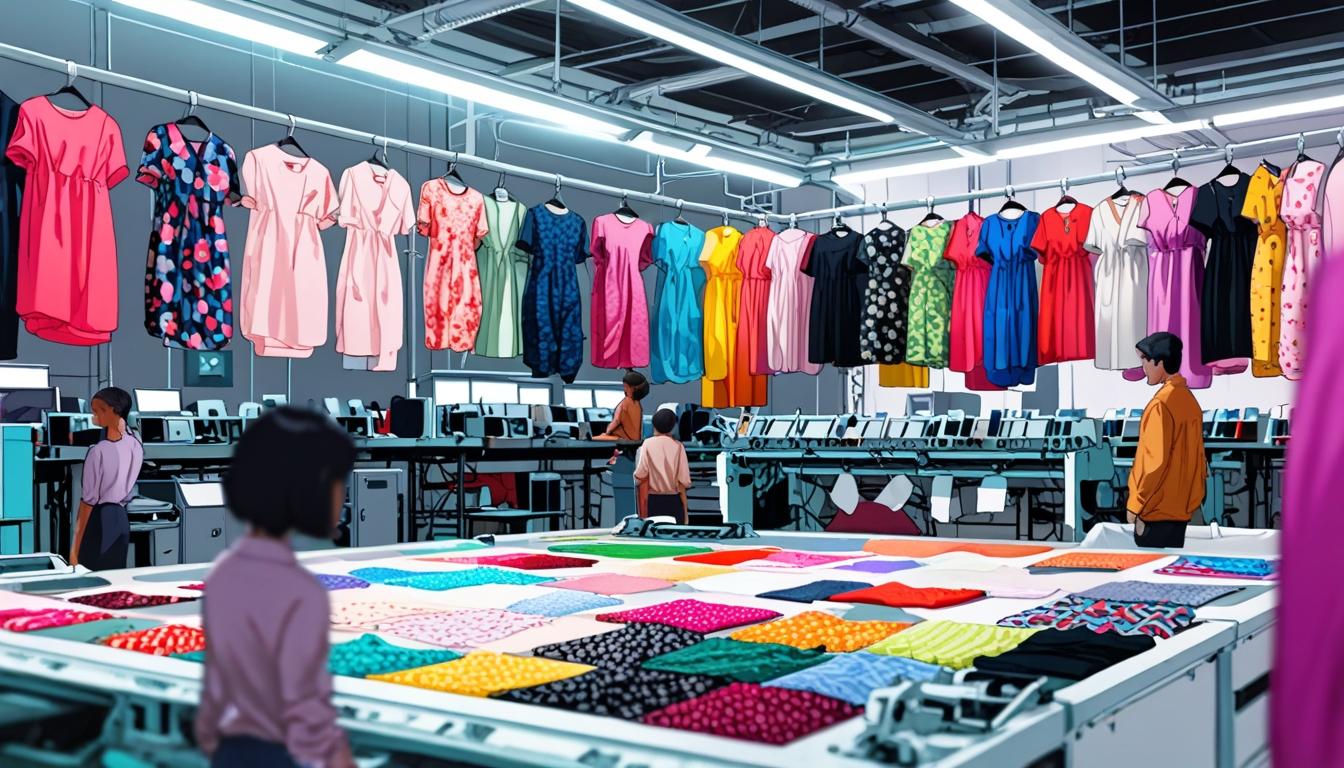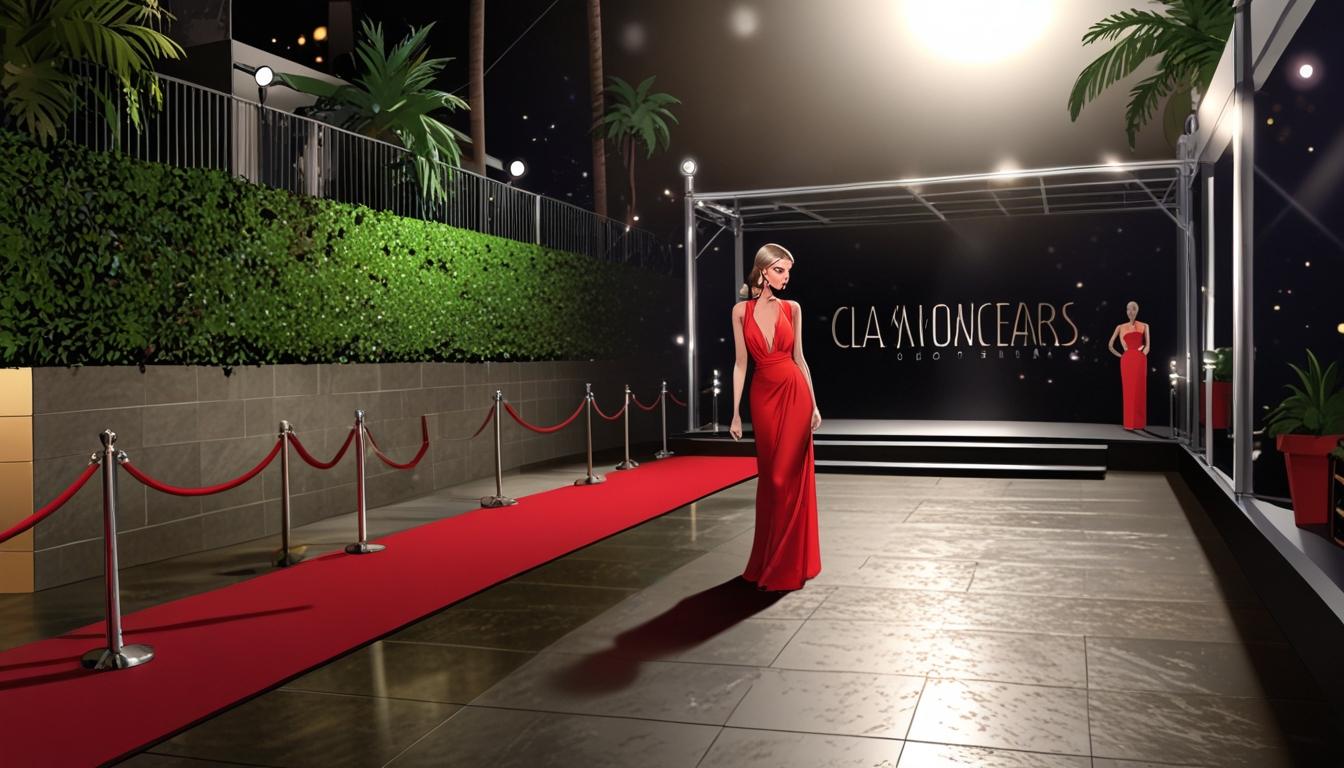You might not realize that the costumes in "Coco Before Chanel" are meticulously crafted to highlight the evolution of Coco Chanel's style, reflecting her journey from a humble seamstress to a fashion icon. Each outfit tells a story, revealing her innovative blend of comfort and elegance that changed women's fashion forever. As you consider the significance of these designs, it's intriguing to explore how they not only capture the essence of the early 20th century but also influence modern fashion trends. What do these choices reveal about Chanel's vision and lasting legacy?
Overview of Coco Chanel's Style
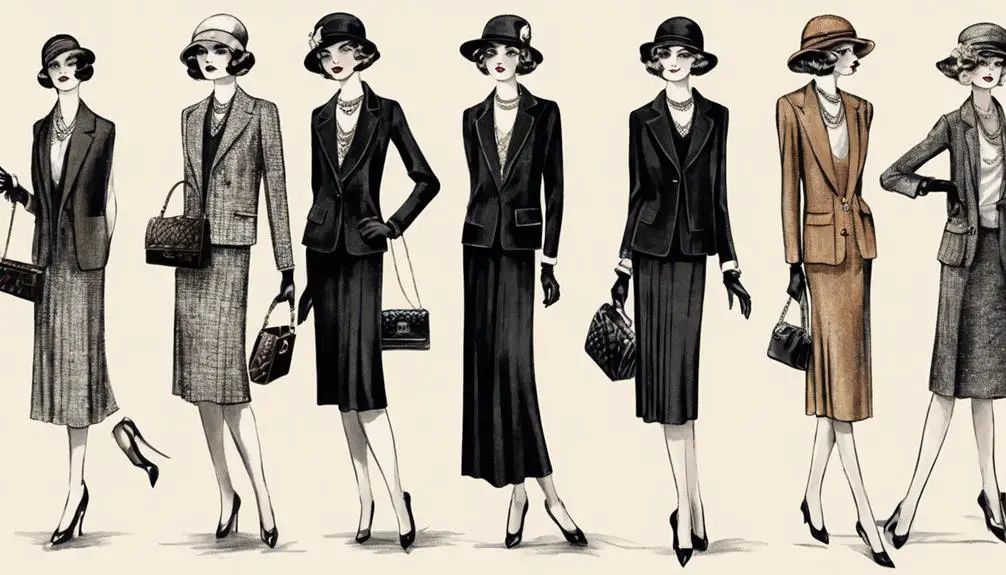
Coco Chanel's style transformed the landscape of women's fashion in the early 20th century, emphasizing comfort and elegance over restrictive designs. You can't help but admire how Coco Chanel revolutionized the way women dressed, moving away from tight corsets and ornate gowns. She popularized a casual chic aesthetic that redefined femininity, making it not only stylish but also practical. The introduction of the iconic "little black dress" in 1926 reimagined this color as a timeless staple, showcasing versatility that Vogue quickly embraced.
Chanel's innovative use of jersey fabric allowed for greater movement, setting a new standard in fashion design that prioritized comfort. Her signature looks, including tailored suits and silk pajamas, blurred the lines between masculine and feminine styles, offering women a fresh, modern approach to dressing. By favoring simplicity, practicality, and neutral colors, Coco Chanel challenged the vibrant, ornate trends of her time and created a lasting legacy that still inspires fashion today. As you explore the world of Coco Chanel, you'll discover how her groundbreaking vision reshaped women's fashion, proving that elegance can indeed coexist with comfort and style.
Notable Outfits in the Film
The film "Coco Before Chanel" beautifully captures the evolution of Chanel's iconic style through a series of notable outfits that reflect her groundbreaking vision. One standout ensemble showcases a distinctive travel outfit, complete with a hat that boldly contrasts the extravagant styles of the era, highlighting Coco's emerging personal aesthetic. You can't miss her signature sailor's breton tee, a perfect example of Chanel's affinity for casual yet chic designs, setting the stage for modern fashion.
Another remarkable piece is a simple yet elegant cream silk pajama set with black edging, which emphasizes comfort as a crucial aspect of Chanel's fashion philosophy. This choice illustrates her belief that style should never compromise comfort. The film also features a customized shirtdress, embodying Coco's innovative approach to individual style and her rejection of restrictive fashion norms that once dominated women's wardrobes.
Costume Design Insights
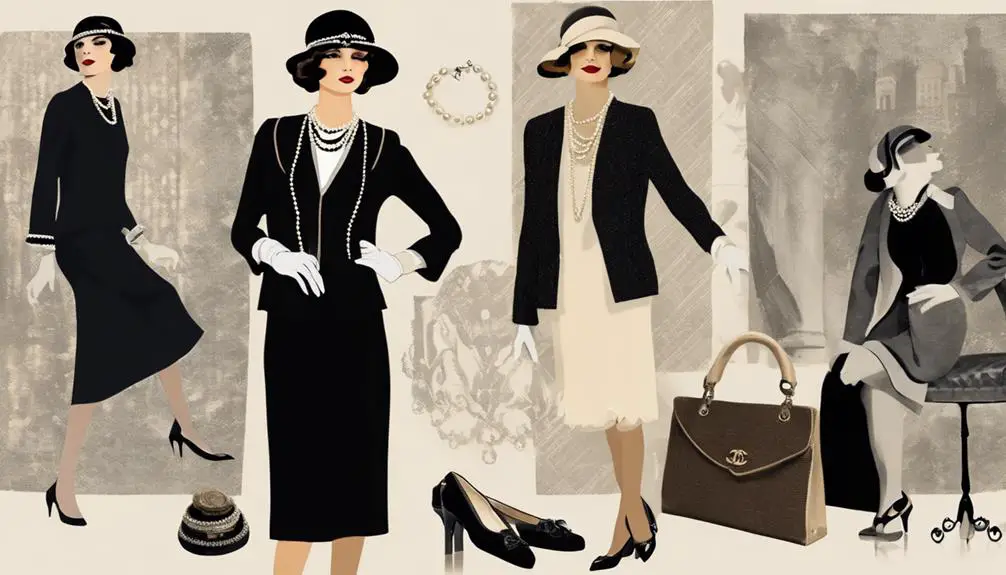
When you explore the costume design of "Coco Before Chanel," you'll see how authenticity plays a vital role in bringing the film's historical context to life. Catherine Leterrier's creative vision draws from Chanel's early inspirations, skillfully weaving in signature aesthetics that echo through time, like the iconic Breton top and elegant silk pajamas. By carefully sourcing accessories and dressing over 700 extras in period-appropriate attire, the film not only captures the essence of late 19th and early 20th-century France but also pays homage to the revolutionary spirit of Chanel herself.
Authenticity in Costume Design
While crafting an authentic portrayal of early 20th-century fashion, costume designer Catherine Leterrier embraced her creative freedom to guarantee every detail resonated with the era's style. She prioritized authenticity, ensuring that over 700 female extras were outfitted in period-appropriate costumes, which helped to create a believable world on screen. Leterrier's meticulous approach included extensive fittings and the sourcing of genuine garments from museums, flea markets, and vintage shops, which added an undeniable layer of realism to the film.
To complement the costumes, notable hats were created by esteemed milliner Stephen Jones, with each piece sketched and commissioned specifically for the film, reflecting Chanel's evolving design aesthetic. Additionally, accessories, including stunning jewelry sourced from the Chanel archives, further enhanced the authenticity and historical relevance of the costumes.
Leterrier's dedication and attention to detail didn't just create outfits; they brought the spirit of the era to life, immersing viewers in the world of Coco Chanel. By prioritizing authenticity, she transformed the film into an enthralling visual experience that honored the legacy of one of fashion's most iconic figures.
Historical Inspirations and References
Costume design in "Coco Before Chanel" draws heavily from historical inspirations, immersing viewers in the essence of early 20th-century fashion. Led by the talented Catherine Leterrier, the costume team conducted extensive research, sourcing genuine garments from museums, flea markets, and vintage shops to guarantee historical accuracy. You'll notice that over 700 female extras were outfitted with period-appropriate costumes, reflecting the rich fashion heritage of late 19th and early 20th century France.
Notable costume elements, like the oversized hats created by milliner Stephen Jones, emphasize Coco's early influences as a milliner before she established her fashion label. These hats not only serve as stunning visual pieces but also connect Coco's past to her future in the fashion industry. Iconic looks, such as the cream silk pajamas with black edging and the blue and white striped Breton top, highlight her revolutionary approach to comfort and style.
The meticulous fitting process documented for each outfit guaranteed authenticity and character accuracy, while sketches were commissioned specifically for portraying Coco Chanel's early life. This attention to detail truly brings "Coco Before Chanel" to life, showcasing the transformative power of fashion.
Signature Chanel Aesthetics
The film "Coco Before Chanel" captures the signature aesthetics that defined Coco Chanel's revolutionary approach to fashion. Led by costume designer Catherine Leterrier, the film features over 700 custom outfits that reflect Chanel's evolving style before she established her iconic fashion empire. You'll notice notable pieces, such as oversized hats crafted by milliner Stephen Jones, emphasizing Chanel's early influence in millinery and setting the stage for her future designs.
Classic elements, like the white pleat-front men's shirt and the blue and white striped Breton top, highlight Chanel's rebellious spirit, demonstrating her innovative blend of masculine and feminine styles. The inclusion of silk crepe and chiffon pajamas exemplifies her emphasis on comfort and elegance, principles that continue to resonate in modern fashion.
Moreover, the meticulous attention to detail in the costumes—such as sourcing jewelry from the Chanel archives—ensures authenticity while capturing the essence of turn-of-the-century France. Each outfit not only reflects Chanel's unique vision but also serves as a representation of her lasting impact on the fashion world, making "Coco Before Chanel" a vibrant celebration of her legacy.
Fashion Evolution Depicted
In "Coco Before Chanel," viewers witness a remarkable fashion evolution as Coco shifts from a modest seamstress to a groundbreaking designer. The film beautifully illustrates her journey, showcasing her preference for boyish silhouettes that challenged the traditional femininity of her time. Unlike the vibrant palettes that dominated women's fashion, Coco opts for darker colors and simpler lines, emphasizing elegance and comfort in her early designs. This innovative approach can be likened to the evolution of Burberry logos, which also reflect changing aesthetics and cultural influences over time.
Notable outfits, such as the introduction of the iconic Little Black Dress, weave a narrative that redefined women's fashion. This dress not only deviated from mourning attire but also gained timeless appeal, as highlighted in a 1926 Vogue article. Throughout the film, you see oversized garments and menswear-inspired elements, reflecting Coco's rejection of ornate styles in favor of practicality and ease, exemplified by her cream silk pajamas with black edging.
Coco's evolution in "Coco Before Chanel" is punctuated by her innovative use of customized clothing and jersey fabric, paving the way for modern fashion. This empowered women to embrace both comfort and style, making her designs revolutionary and unforgettable.
Signature Looks and Elements
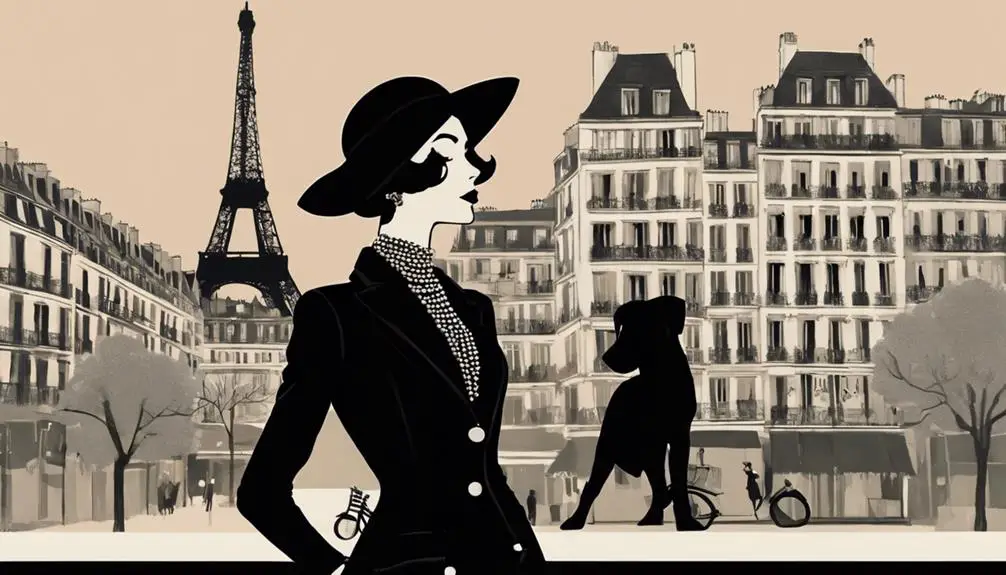
In "Coco Before Chanel," you'll discover how Coco's signature looks transformed the fashion landscape, starting with the iconic Little Black Dress that redefined elegance and versatility. You'll also see her menswear-inspired ensembles, like tailored vests and jodhpurs, which boldly challenged the norms of femininity during her time. And let's not forget the timeless Breton stripe, a casual yet chic element that perfectly captures Chanel's innovative spirit and love for comfort.
Iconic Black Dress
Coco Chanel's iconic black dress, often dubbed the Little Black Dress (LBD), revolutionized women's fashion in the 1920s. In the film "Coco Before Chanel," actress Audrey Tautou brings to life Chanel's vision, showcasing how this simple yet elegant garment transformed the fashion landscape. Originally seen as a symbol of mourning, Chanel redefined the LBD into a versatile piece that embodies sophistication and style.
The 1926 Vogue famously labeled Chanel's creation as "a Ford," emphasizing its accessibility and timeless appeal, making it as essential as the automobile. Characterized by clean lines and understated elegance, the LBD allows for limitless styling possibilities, empowering you to express your individuality and comfort. Whether paired with pearls for a classic look or accessorized with bold accessories for a modern twist, the black dress adapts to any occasion.
Chanel's groundbreaking introduction of the LBD as a wardrobe staple continues to influence contemporary fashion, with countless designers citing it as a foundational piece for women's attire. Embrace the legacy of Coco Chanel and discover how the Little Black Dress remains a symbol of elegance, versatility, and empowerment in your own closet.
Menswear-Inspired Ensembles
Chanel's menswear-inspired ensembles revolutionized women's fashion by effortlessly blending masculine elements with feminine elegance. In "Coco Before Chanel," you see how Coco Chanel's early designs boldly rejected traditional feminine styles, showcasing tweedy vests, jodhpurs, and neckties. One standout piece is the oversized white pleat-front men's shirt, which symbolizes her rebellious spirit and desire to transform women's wardrobes.
Costume designer Catherine Leterrier skillfully crafted outfits that highlight Chanel's pioneering approach, like the cream silk pajamas with black edging that emphasize both comfort and sophistication. You can't overlook the iconic tweed coat, which encapsulates the essence of Chanel's philosophy: merging functionality with high fashion.
Throughout the film, you'll notice how these menswear-inspired pieces create a new narrative in women's fashion, allowing women to express themselves more freely and confidently. The garments, including silk crepe and chiffon pajamas, continue to inspire modern fashion trends, demonstrating that elegance and comfort can coexist beautifully. By embracing these elements, Chanel paved the way for future generations to explore their identities through style, making her influence as relevant today as it was in her time.
Timeless Breton Stripe
Worn by fashion icons and everyday enthusiasts alike, the iconic blue and white striped Breton top featured in "Coco Before Chanel" embodies a timeless appeal that transcends trends. Originally inspired by the nautical attire of fishermen, the timeless Breton stripe symbolizes a perfect blend of comfort and style that Coco Chanel championed in women's fashion. This relaxed silhouette marked a significant shift away from the restrictive clothing norms of the past, promoting a chic, casual aesthetic that resonates even today.
The film showcases various iterations of the Breton top, letting you see just how versatile this classic piece can be. Whether you pair it with tailored trousers or a flowing skirt, the Breton top effortlessly elevates any outfit, making it suitable for a range of occasions. Its enduring popularity is evident in modern collections, reinforcing its status as a fashion classic that never goes out of style.
Inspirations From Menswear
Drawing inspiration from menswear, Coco Chanel revolutionized women's fashion by introducing oversized garments that broke away from the restrictive styles of her time. By cleverly adapting traditionally masculine elements, she created a new aesthetic that emphasized practicality and comfort. This innovative approach paralleled the principles of assessing fit and making adjustments, ensuring that garments not only looked stylish but also fit well. Her designs not only challenged societal norms but also set the foundation for modern femininity.
Here are four key inspirations from menswear that Chanel incorporated into her iconic looks:
- Tailored Jackets: Chanel often borrowed jackets from her male lovers, reimagining them for women, which led to the creation of the timeless Chanel suit.
- Jodhpurs: These fitted trousers showcased her belief that women could embrace both style and functionality, moving away from skirts and corsets.
- Neckties: Incorporating neckties into her outfits illustrated her playful blend of masculine and feminine aesthetics, adding a touch of androgyny to her designs.
- Breton Tee: The classic sailor's tee became a staple in her collections, reflecting her love for combining relaxed menswear with feminine flair.
Chanel's ability to merge these elements not only changed fashion but also empowered women to express their individuality.
Cultural Impact of Costumes
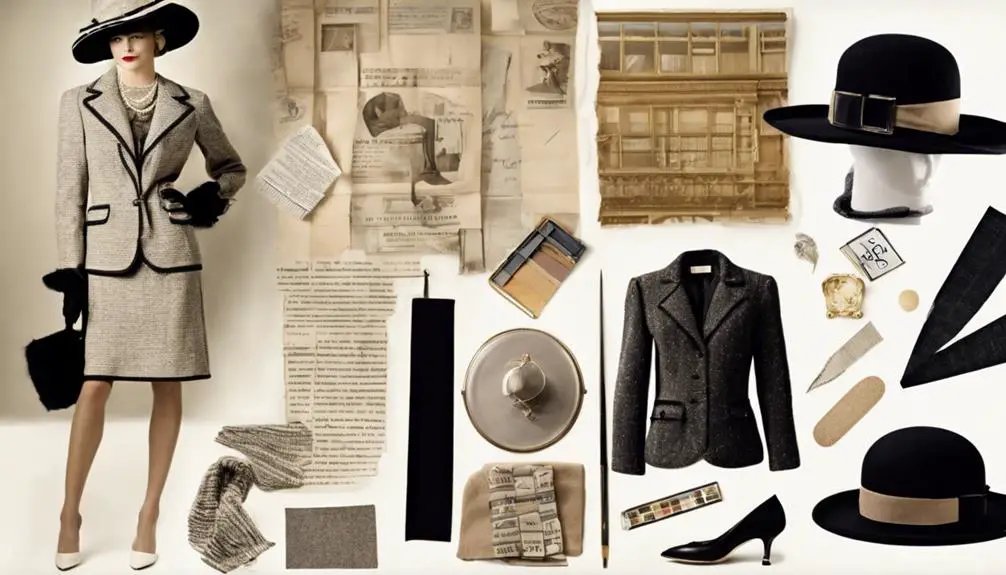
Costumes in "Coco Before Chanel" frequently highlight the pivotal change in women's fashion during the early 20th century. Designed by Catherine Leterrier, these costumes illustrate Coco Chanel's revolutionary impact on women's clothing, marking a transition from restrictive styles to more casual and elegant forms. The film's authenticity shines through with over 700 period-appropriate costumes for female extras, immersing you in the cultural context of Chanel's early life. Vivienne Westwood, renowned for her innovative fashion designs, similarly challenged traditional norms through her impactful collections that blended historical references with contemporary themes.
Iconic pieces, like the blue and white striped Breton top, symbolize Chanel's departure from traditional femininity, embracing menswear-inspired fashion that continues to influence contemporary trends. You can see how Chanel's belief in combining comfort with elegance comes to life through luxurious fabrics like silk crepe and chiffon in her pajamas. This approach resonates with modern fashion sensibilities, proving that comfort can indeed be chic.
Moreover, the meticulous attention to detail, including oversized hats and custom ensembles, reinforces the cultural impact of Chanel's designs. By transforming women's wardrobes and challenging societal norms, the costumes in this film not only celebrate Chanel's legacy but also serve as a reminder of the ongoing evolution of women's fashion.
Legacy of Coco's Fashion
Coco Chanel's fashion legacy is a powerful demonstration of her revolutionary vision, reshaping how women perceive and wear clothing. With her groundbreaking designs, she challenged norms and created an enduring impact that resonates in today's fashion world. Here are four key aspects of her legacy:
- The Little Black Dress: Introduced in 1926, this classic Chanel piece transformed women's wardrobes, symbolizing elegance and versatility.
- Jersey Fabric: By popularizing this comfortable material, she brought practicality to women's fashion, previously reserved for menswear.
- Menswear Inspirations: Chanel's tailored suits and oversized garments blurred gender lines, encouraging women to embrace a more androgynous style that empowered self-expression.
- Casual Chic: Her focus on comfort and casual elegance shifted the fashion paradigm away from restrictive corsets, allowing women greater freedom in their style choices.
Today, Coco's influence is still felt, as her designs inspire contemporary trends and celebrate individuality. From the classic Chanel aesthetic to modern interpretations, her legacy continues to empower women, ensuring that her revolutionary vision remains relevant in the ever-evolving fashion landscape.
Frequently Asked Questions
What Was Coco Chanel's First Piece of Clothing?
Coco Chanel's first piece of clothing was a simple black dress made from a discarded curtain. This creation reflected Chanel's inspiration for practicality and elegance, marking her departure from the elaborate styles of her time.
What Did Coco Chanel Do Before Becoming a Fashion Designer?
Before becoming a fashion designer, you'll find that Coco Chanel had an early career as a seamstress and milliner. She crafted hats that captured the elite's attention, shaping her unique design perspective.
How Did Coco Chanel Change Fashion?
Imagine a world where comfort and elegance stroll hand in hand. Coco Chanel sparked a fashion revolution, transforming women's wear with timeless designs, liberating styles, and a bold embrace of simplicity that redefined femininity forever.
Did Coco Chanel Design Her Own Clothes?
Yes, Coco Chanel designed her own clothes, showcasing her design influence on fashion. She blended comfort and elegance, creating iconic pieces like the Little Black Dress, which transformed women's style and challenged traditional norms.


